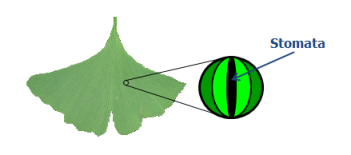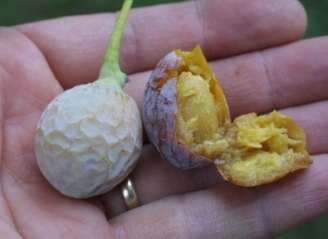Adaptation
Ginkgo biloba has so many unique adaptations. These
include everything from resistance to insects, pollution, and
fungicides to their incredibly long life span.
Stomata:
Ginkgo biloba has adapted over the years by the placement of
their stomata. Stomata are pores that allow for gas exchange (carbon dioxide,
oxygen, and
 water
vapor) between the internal environment of the leaf and the external
environment. When a Ginkgo tree is just beginning to grow, the stomata
are located on the upper side of the leaf because this is the part of
the plant that is first able to “breathe” air.
water
vapor) between the internal environment of the leaf and the external
environment. When a Ginkgo tree is just beginning to grow, the stomata
are located on the upper side of the leaf because this is the part of
the plant that is first able to “breathe” air.
*The picture above and to the right shows an illustration of an enlarged stomata from a Ginkgo leaf. The picture of the
Ginkgo
leaf was taken by Strizale from
Flickr.com and I have modified it to show an enlarged stomata.
Toxicity of outer covering on seeds:
The toxicity of the outer covering on the seed is another
adaptation. In
ancient China, people used to eat this outer layer but
they found that they developed rashes and sometimes became
violently ill. It didn’t take them long to realize that once
they roasted the seeds, they could gai n
the benefits of Ginkgo biloba
without getting sick from the toxic "fruit". This "fruit"
also deters other predators from eating the seed as well.
n
the benefits of Ginkgo biloba
without getting sick from the toxic "fruit". This "fruit"
also deters other predators from eating the seed as well.
Toxicity of the leaves:
Another somewhat toxic part of
the plant is the leaves. Usually the leaves do not contain enough
toxicity to affect humans; however, insects remain very susceptible to
the toxin and they usually avoid this plant.
Life Span:
The life span of the Ginkgo tree is
extremely long. There are plants still around today that began growing
about 1000 years ago! Having 1000 birthdays is a definite plus when it
comes to reproduction. The longer the plant lives the more likely it is
to have reproductive success and produce many more Ginkgo
trees.
Speaking of reproduction, click HERE to learn how
Ginkgo bilboa reproduces!
HOME
